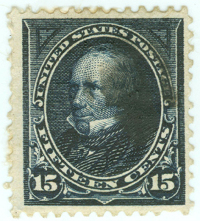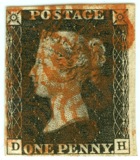
Discussion - Member to Member Sales - Research Center

Discussion - Member to Member Sales - Research Center


Many thanks in advance,
Andrew

Login to Like
this post

06:58:29pm
" ... My brain seems to recall reading that a lot of early Brit Commonwealth stamps did double duty in some countries as revenue stamps. These revenue stamps were commonly cancelled by pen. ..."
Your recollection is quite correct.
Unless someone can unearth some exception it is almost certainly a Revenue Cancellation and the catalog listing is, as you recall, for postal usages.
Curiously some revenue usages on colonial stamps might actually be even more rare in absolute numbers, but the demand side of the popular equation has its effect. There are far more postal stamp collectors than those interested and willing to pay a premium for revenue usages.

Login to Like
this post
The general rules of thumb with Scott is this: unless it is specifically stated otherwise in the catalog, the used value for a revenue cancel is about 10% of stated catalog value for a postally used stamp.
Now your stamp has an additional issue. The used value for Scott Fiji #67 is italicized. That means that the used valued is for a stamp that was used during the time period that the stamp was in general use.
So, to figure out what to do, you must use the unused value for the stamp. In 2011, Scott had a value assigned to the stamp of $12.50. That means with the revenue cancellation, your stamp would have a retail value of $1.25 for fine-very fine condition.

Login to Like
this post

10:17:23am
How would a "Rule of Thumb" between postally used stamps and a revenue canceled stamp be an accurate representation of its value in relation to a mint stamp ?

Login to Like
this post
Because in this case, a stamp that was used for postage during the time that the stamp was in use is scarce, while unused examples are more common. So, you can't use the used value to determine the value of a revenue canceled stamp, which probably is more commonly found having been used for revenue purposes. If the used value was not italicized, meaning that there are plenty of used examples around, then you would use the used value.
Take the German depression-era stamps. Genuinely used stamps are scarce, and the values are italicized because of that. CTO and stamps with forged cancels abound. Scott even notes that you must use the unused value for used German stamps of this era unless you have certification that the stamp is genuinely used.
Look at Malaya Scott #37. The used value for a postally used example in the 2011 Scott is $975.00, NOT italicized. Revenue cancel value is given at $42.50. Scott #36 is a good example of Scott using the 10% rule of using the unused value due to the used value being italicized. Unused is $225.00, with revenue cancel listed at $22.50.

Login to Like
this post
Michael,
Thanks very much for the information. You've definitely helped to clear this up for me.
Andrew

Login to Like
this post

Hi there. I found this stamp in an old purchase of Brit Comm stamps that I was going through. I verified the watermark (#2) and checked my library copy of 2012 Scott's. Wow! A used example is priced at $75.00. Now my question: Does the pen cancel reduce the value of the stamp I have pictured here? My brain seems to recall reading that a lot of early Brit Commonwealth stamps did double duty in some countries as revenue stamps. These revenue stamps were commonly cancelled by pen. There were no notes in the catalogue regarding this, so I'm hoping there are some Brit Comm experts that can shed some light on the pen cancel that's pictured here.

Many thanks in advance,
Andrew

Login to Like
this post
Silence in the face of adversity is the father of complicity and collusion, the first cousins of conspiracy..
06 Oct 2011
06:58:29pm
re: Fiji: Scott # 67 with manuscript cancel
" ... My brain seems to recall reading that a lot of early Brit Commonwealth stamps did double duty in some countries as revenue stamps. These revenue stamps were commonly cancelled by pen. ..."
Your recollection is quite correct.
Unless someone can unearth some exception it is almost certainly a Revenue Cancellation and the catalog listing is, as you recall, for postal usages.
Curiously some revenue usages on colonial stamps might actually be even more rare in absolute numbers, but the demand side of the popular equation has its effect. There are far more postal stamp collectors than those interested and willing to pay a premium for revenue usages.

Login to Like
this post
03:56:55pm
re: Fiji: Scott # 67 with manuscript cancel
The general rules of thumb with Scott is this: unless it is specifically stated otherwise in the catalog, the used value for a revenue cancel is about 10% of stated catalog value for a postally used stamp.
Now your stamp has an additional issue. The used value for Scott Fiji #67 is italicized. That means that the used valued is for a stamp that was used during the time period that the stamp was in general use.
So, to figure out what to do, you must use the unused value for the stamp. In 2011, Scott had a value assigned to the stamp of $12.50. That means with the revenue cancellation, your stamp would have a retail value of $1.25 for fine-very fine condition.

Login to Like
this post
Silence in the face of adversity is the father of complicity and collusion, the first cousins of conspiracy..
16 Oct 2011
10:17:23am
re: Fiji: Scott # 67 with manuscript cancel
How would a "Rule of Thumb" between postally used stamps and a revenue canceled stamp be an accurate representation of its value in relation to a mint stamp ?

Login to Like
this post
10:04:42pm
re: Fiji: Scott # 67 with manuscript cancel
Because in this case, a stamp that was used for postage during the time that the stamp was in use is scarce, while unused examples are more common. So, you can't use the used value to determine the value of a revenue canceled stamp, which probably is more commonly found having been used for revenue purposes. If the used value was not italicized, meaning that there are plenty of used examples around, then you would use the used value.
Take the German depression-era stamps. Genuinely used stamps are scarce, and the values are italicized because of that. CTO and stamps with forged cancels abound. Scott even notes that you must use the unused value for used German stamps of this era unless you have certification that the stamp is genuinely used.
Look at Malaya Scott #37. The used value for a postally used example in the 2011 Scott is $975.00, NOT italicized. Revenue cancel value is given at $42.50. Scott #36 is a good example of Scott using the 10% rule of using the unused value due to the used value being italicized. Unused is $225.00, with revenue cancel listed at $22.50.

Login to Like
this post

re: Fiji: Scott # 67 with manuscript cancel
Michael,
Thanks very much for the information. You've definitely helped to clear this up for me.
Andrew

Login to Like
this post

